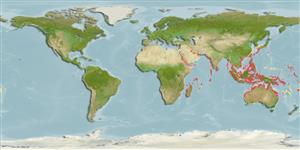Environment: milieu / climate zone / depth range / distribution range
นิเวศวิทยา
เกี่ยวกับทะเล,น้ำเค็ม; กร่อย เกี่ยวกับหินโสโครก; ระดับความลึก 3 - 15 m (Ref. 90102). Tropical
Indo-Pacific: Red Sea, Mozambique (Ref. 5285), and Papua New Guinea. Reported from East Asia, Yakushima Island as the northermost record (Ref. 82830).
ขนาด / น้ำหนัก / Age
Maturity: Lm ? range ? - ? cm
Max length : 15.0 cm TL เพศผู้/กระเทย; (Ref. 90102)
เงี่ยงครีบหลัง (รวม) : 12; ก้านครีบอ่อนที่หาง (รวม) : 8 - 9; เงี่ยงครีบก้น: 3; ก้านครีบอ่อนที่ก้น: 5.
Found in shallow coastal lagoons, large intertidal pools or estuaries; also in silty reefs or amongst large coral rubble (Ref. 48635).
Life cycle and mating behavior
Maturities | การสืบพันธุ์ | Spawnings | Egg(s) | Fecundities | ตัวอ่อน
Kailola, P.J., 1987. The fishes of Papua New Guinea: a revised and annotated checklist. Vol. II Scorpaenidae to Callionymidae. Research Bulletin No. 41, Research Section, Dept. of Fisheries and Marine Resources, Papua New Guinea. (Ref. 6192)
IUCN Red List Status (Ref. 130435)
Threat to humans
Harmless
Human uses
เครื่องมือ
Special reports
Download XML
แหล่งที่มาจากอินเตอร์เน็ต
Estimates based on models
Preferred temperature (Ref.
123201): 24.9 - 29.3, mean 28.5 °C (based on 2844 cells).
Phylogenetic diversity index (Ref.
82804): PD
50 = 0.5078 [Uniqueness, from 0.5 = low to 2.0 = high].
Bayesian length-weight: a=0.01380 (0.00814 - 0.02341), b=3.02 (2.87 - 3.17), in cm total length, based on LWR estimates for this species & (Sub)family-body (Ref.
93245).
ระดับชั้นอาหาร (Ref.
69278): 3.7 ±0.4 se; based on size and trophs of closest relatives
ความสามารถในการกลับคืนสู่ปกติ (Ref.
120179): ขนาดกลาง, เวลาต่ำสุดที่จะทำให้ประชากรเพิ่มขึ้นเป็น 2 เท่าใช้เวลา 1.4 - 4.4 ปี (Preliminary K or Fecundity.).
Fishing Vulnerability (Ref.
59153): Low vulnerability (10 of 100).
Nutrients (Ref.
124155): Calcium = 85.2 [40.8, 198.8] mg/100g; Iron = 0.674 [0.337, 1.593] mg/100g; Protein = 18.5 [16.5, 20.5] %; Omega3 = 0.23 [0.09, 0.62] g/100g; Selenium = 19 [9, 47] μg/100g; VitaminA = 163 [50, 503] μg/100g; Zinc = 1.81 [1.21, 2.65] mg/100g (wet weight);
